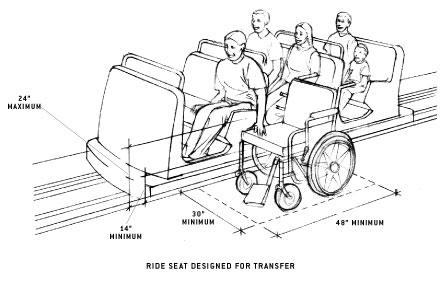Accessible Amusement Rides - A Summary of Accessibility Guidelines for Recreation Facilities
Amusement Ride Seats Designed for Transfer
Where an amusement ride seat is designed for transfer,it is expected that someone will transfer only once from a wheelchair or mobility device to the ride seat. Amusement ride seats designed for transfer should allow individuals to make independent transfers to and from their wheelchairs or mobility devices. There are many different ways that individuals transfer from their wheelchairs or mobility devices. Both the clear space and the height of the seat are critical for a safe and independent transfer. When greater distances are required for transfer, consideration should be given to providing gripping surfaces, seat paddings, and avoiding sharp or protruding objects.
Clear Floor Space
The load and unload areas adjacent to ride seats designed for transfer must have a clear space of 30 by 48 inches minimum. Designers may decide which location is best suited for transfer on a particular ride.Because people transfer in different ways, providing additional space both in front of and to the side of the ride will increase flexibility and usability for a more diverse population.
Transfer Height
Ride seats designed for transfer must be between 14 and 24 inches above the load and unload area surface. Where possible, designers are encouraged to locate the ride seat within 17 to 19 inches above the load and unload surface.
Transfer Entry
There is a large amount of variance in amusement rides and the sides of the ride are often part of the restraint or securement system. For those reasons, the opening provided to transfer from a wheelchair or mobility device must provide sufficient clearance for transfer.


User Comments/Questions
Add Comment/Question